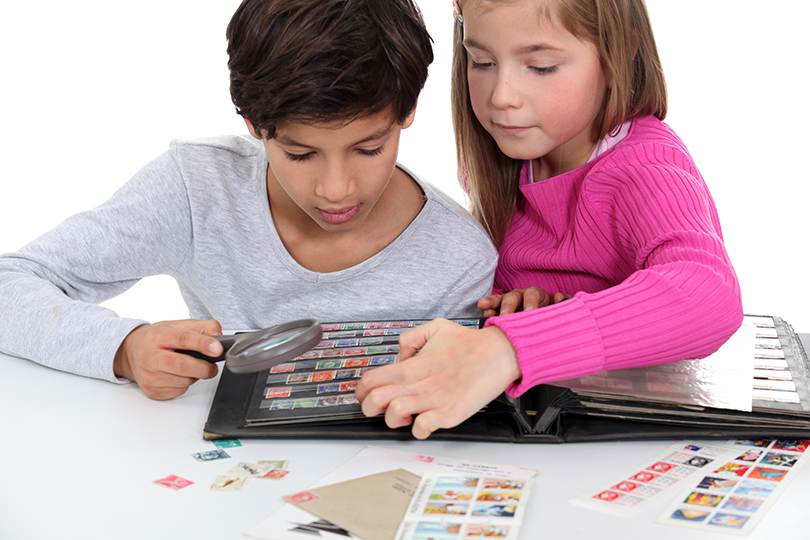Kid Collections
A Great Way to Boost Science Processing Skills
By Jan Pierce

Have you noticed that any time you’re outside with children they naturally begin to pick things up and “collect” them? It’s part of their natural curiosity about the world and it is a wonderful thing. Nurture that curiosity by encouraging the children in your life to make collections of all kinds. Younger children can choose three or four treasures to save and display. Older children are able to do ever more detailed collections of all kinds.
In addition to awakening the wonder at the vast bounty of our natural world, children also respond to the “fun of the hunt” involved in collecting things. From an educational point of view, collections also lend themselves to basic math and science learning. Younger children can sort by size, color, shape and pattern. Older children will learn to identify, label, organize into categories and classify their treasures in many different ways. Parents can support these learning activities by allowing collections display space in the home. Many children enjoy creating their own “museum” for a period of time. They will naturally want to add drawings, short informational descriptions, and charts. Voila! You have created an engaged learner!
What to collect? The possibilities are endless. Some favorites from the natural world include rocks and minerals, shells, feathers, bark, leaves, pinecones, insects, butterflies and moths. Other collectibles might include coins, stamps, stickers, miniature toys, dolls, bottle caps, comic books, gum wrappers, buttons or marbles. If there are a lot of them around, you can collect them.
Support your children’s wonder and joy in the intricacies of nature by creating lists of beautiful things seen, favorite hikes or places to play and anything else that builds children’s appreciation of the beauty around us. Display the charts and lists on walls to be read and enjoyed in times to come. Such activities will increase logical thinking skills and will involve organization of factual information in the process of writing.
Children who develop a passion for their collections will also gain self-confidence and will learn to share their passion with others. They’ll talk about their collections, share and trade items with others, and otherwise engage in social skills. They will “own” their collection in such a way as to gain in responsibility and care-giving of something valuble to them.
They’ll increase their knowledge base of a certain subject area. If they have chosen to collect bird nests they may also learn all about the habitats of birds, their diet, their size, shape and defining marks. They’ll want to observe birds in their natural habitat and they’ll ask questions, make inferences, synthesize information and engage in many scientific processing skills. They will be independent learners.
Adults can further encourage such independent learning by purchasing appropriate books, field guides and posters related to the collection of the day. You might even want to have a disposable camera or binoculars on hand for capturing images during impromptu nature walks. Keep poster board on hand to be ready for those inspired lists, charts and drawings that will make up displays of collected items. See the following list of ideas to get you started. Happy collecting!
Resources:
Practicing Science Process Skills at Home by Debbye Vitti and Angie Torres, 2006.
Research Matters to the Science Teacher, National Association for Research in Science by Michael J. Padilla, University of Athens, Georgia, 1990, 2013.
*This article first appeared in The Mother’s Heart Magazine in the May/June 2013 issue.
Books on Kid Collections
• The Kids’ Nature Book: 365 Indoor/Outdoor Activities and Experiences by Susan Milford
• Nature Smart: A Family Guide to Nature by Tekiela and Shanber
• Field Guides by the Audubon Society
• The Insect Book: A Basic Guide to Collection and Care of Common Insects for Young Children by Connie Zakowski
• Kids Collect: Amazing Collections for Fun, Crafts and Science Fair Projects by Dan and Mary Hubley
• Collecting Bugs and Things by Julia Spencer
• Collecting Things is Fun by Kimberlee Graves
• The Usborne Book of Collecting Things by Ray Gibson
• Let’s Go Rock Collecting by Roma Gans and Holly Keller
Craft items to keep on hand for displaying collections
• Cardboard boxes and the inside dividers
• Tape
• Glue
• Markers
• String, twine
• Scissors
• Fabric scraps
• Clothespins to hand items
• Lumber scraps
• Styrofoam trays
• Cans
• Plastic containers with lids
• Old picture frames
• Saran Wrap
• Clear contact paper
• Paper bags
• Plastic bags
• Clip Boards for recording data
• Children’s binoculars
• Waxed paper
Basic Science Processing Skills Enhanced through Creating Kid Collections
Observation: Noticing alike and different, noticing unique features, using our five senses to record information.
Classification: Sorting and Organizing according to a property such as size, shape or color.
Measurement: Finding the length, width, or other quantity using a measuring tool.
Communication: Sharing information with others, relating facts.
Making inferences: Using data to speculate on factual information.
Making predictions: Using data to predict an outcome.
Interpretation of factual data: Making meaning from data gathered, answering questions posed.
Experimentation: Posing questions, designing a test, logging data and trying out possible solutions to problems.
Inquiry: Asking appropriate questions to determine an outcome or evaluate a circumstance.
Jan Pierce, M.Ed., is a retired teacher and freelance writer. She explores the out of doors with her three grandsons who are avid collection-makers.


